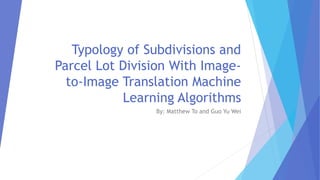
Parcel Lot Division with cGAN
- 1. Typology of Subdivisions and Parcel Lot Division With Image- to-Image Translation Machine Learning Algorithms By: Matthew To and Guo Yu Wei
- 2. Research Questions How to simplify the approach to divide various subdivisions into typologies? Is an "image-to-image translation with conditional adversarial nets" a viable machine learning algorithm for subdivision planning?
- 3. Subdivision Classification – Means to an End? What should subdivisions be classified for? Identification for planning design Simplifying the pix2pix algorithm
- 4. Subdivision Classification – Means to an End? What should subdivisions be classified for? Identification for planning design Simplifying the pix2pix algorithm Same goal!
- 5. Subdivision Classification Proposed Techniques Manual classification Individual judgement by principles Planning design resources Classification by statistics of attributes Density of housing via average parcel size Road to subdivision ratio Machine learning? Do we classify both target and input data?
- 6. Subdivision Classification Manual classification Few training datasets (30, planned 100) Shape analysis easier with humans than computers Selective modification Automated classification may be used once number of datasets far exceeds human capabilities or reliable method of classification is found Originally from Report for the President's Conference on Home Building and Home Ownership, 1932 by Thomas Adams and Walter Baumgarten Retrieved from Street Standards and the Shaping of Suburbia by Southworth and Ben-Joseph
- 7. Parcel Lot Division with pix2pix pix2pix = conditional generative adversarial network (cCAN) TensorFlow implementation 1. Takes a collection of image pairs 2. Creates a model 3. Uses model to produce output Why pix2pix? Designed to be general-purposed No other accessible algorithm currently
- 8. Conditional Generative Adversarial Network (cGAN)? Conditional = takes user input to create output Generative = creates estimated outputs that improves with more training Adversarial = creates two neural networks (generator and discriminator) to compete for a better output (Artificial) Neural Network = machine learning system which takes input, processes the data within “hidden layers”, and returns an output Images retrieved from https://affinelayer.com/pix2pix/, by Hesse
- 9. Conditional Generative Adversarial Network (cGAN)? Conditional = takes user input to create output Generative = creates estimated outputs that improves with more training Adversarial = creates two neural networks (generator and discriminator) to compete for a better output (Artificial) Neural Network = machine learning system which takes input, processes the data in “hidden layers”, and returns an output Images modified from https://affinelayer.com/pix2pix/, by Hesse
- 10. Methodology Training and target data retrieval and clean-up Export shapefiles into images Categorize training data Train and test pix2pix model Perform image segmentation on output
- 11. Methodology Training and target data retrieval and clean-up Export shapefiles into images Categorize training data* Train and test pix2pix model Perform image segmentation on output * Only one result will have training data categorized
- 12. Training Data Study area: Independent of source, however data is from Kitchener-Waterloo area Rules: When training with borders, roads must be one colour, lots (pre and post development) must be another When training with four colours, no lot with same colour can intersect All lots in training data must have a road bordering No redundancies (adds too much weight)
- 13. Results!
- 14. Experiment 1: Three Datasets Input: Target: Output:
- 15. Experiment 1: Analysis It tried. Was unable to represent borders Patterns did not adapt to input polygon
- 16. Experiment 2: Larger Borders Input: Target: Output:
- 17. Experiment 2: Larger Borders Borders are better drawn compared to Experiment 1 Borders do not connect well Shapes are unstructured Lots generated in-land without a bordering road Rule where every lot must border a road was not enforced
- 18. Experiment 3: 29 Datasets
- 21. Experiment 3: Rules Broken!
- 22. Experiment 3: Analysis Lines are shaky, but structured Lots are very small Lots with no backdoor neighbours are somewhat accurately represented Large parcel areas are poorly segmented with weird lot generation in the middle Areas with backdoor neighbours (between two roads) are inconsistent Overall a major improvement from Experiment 1 and 2 Better cleanup may have changed result of data
- 23. Experiment 4: Categorized Datasets Categorized based on road surrounding subdivision and dense neighbourhoods 11 Training Datasets
- 24. Experiment 4: Outputs (native)
- 26. Experiment 3 (left) vs. 4 (right)
- 27. Experiment 4: Analysis Lines are shaky Better than Experiment 3 at parcel division based on its own specialization Parcels without backdoor neighbours are represented fairly well, not as good as Experiment 3 Consistent lot sizes Bubbly housing lots similar to Experiment 2
- 28. Four Colour Theorem Any arrangement of polygons on a 2D surface only requires four colours without any of the colours intersecting
- 29. Experiment 5: Four (Five) Colour Theorem Selected nine random parcels Assigned red to roads, four common colours for lots in training data
- 31. Experiment 5: Analysis Colour separation is fairly discrete (easy image segmentation) Output similar to experiment 2 and 4; bubbly output Lots without backdoor neighbours are somewhat well divided No coherent structure
- 32. Limitations About 30 training datasets at the most Many trained models use tens of thousands Even less for categorized datasets (Experiment 4) Algorithm is extremely resource intensive (512x512 is soft-cap limit) 16 minutes to train 29 images with a GTX 1060 6GB Various technical variables and terminology makes it difficult for non- scientists or statisticians to understand in-depth Epoch (Iterations) Layers/Generator and Discriminator Filters Gradients Steps
- 33. Overall Results Analysis None of the experiments produce data close to target data Experiment 3 hints more training data produces better shaped lots Experiment 4 hints that categorization maintains consistency (against target data) Application of four colour theorem (Experiment 5) is indeterminant
- 34. Next Steps Multiple types of subdivision classification (at least one category with 50+ datasets) Train at least 100 subdivisions (aggregate) Play with pix2pix internal variables (max epochs, layers, steps)
- 35. Thanks for listening! Questions or suggestions?